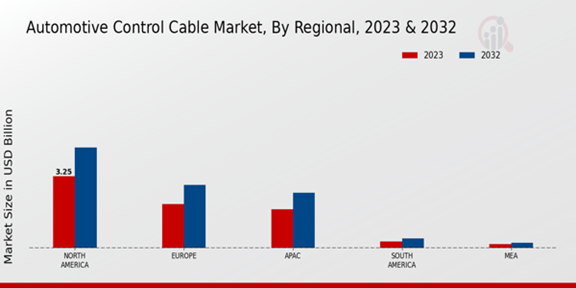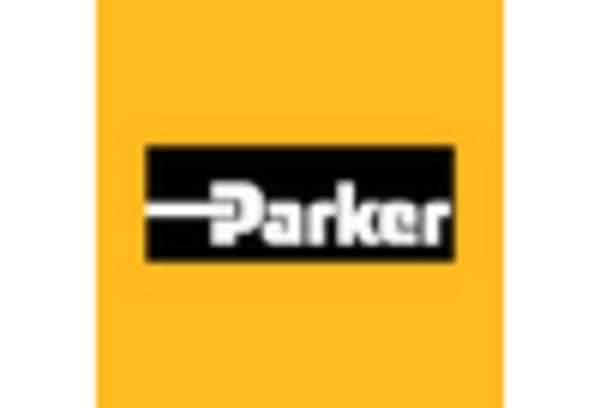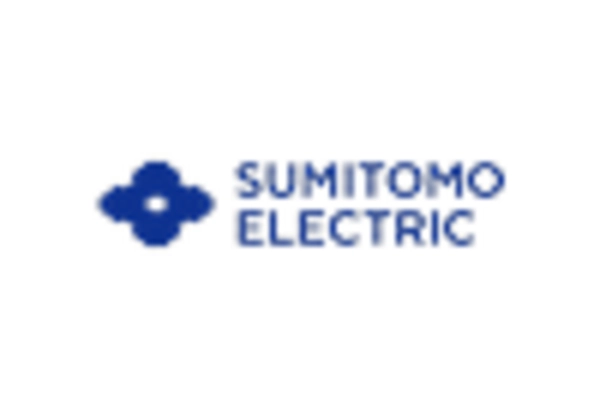Rising Vehicle Production
The Automotive Control Cable Market is experiencing growth due to the increasing production of vehicles worldwide. In recent years, the automotive sector has seen a surge in demand, driven by factors such as urbanization and rising disposable incomes. As manufacturers ramp up production to meet consumer needs, the demand for automotive control cables, which are essential for various vehicle functions, is likely to rise. In 2025, the production of passenger cars is projected to reach approximately 80 million units, indicating a robust market for automotive components. This trend suggests that the Automotive Control Cable Market will continue to expand as vehicle manufacturers seek reliable and efficient components to enhance vehicle performance.
Technological Innovations
Technological advancements play a pivotal role in shaping the Automotive Control Cable Market. Innovations in materials and manufacturing processes have led to the development of lightweight and durable control cables, which enhance vehicle efficiency and performance. For instance, the introduction of high-strength polymers and advanced coatings has improved the longevity and reliability of these cables. Furthermore, the integration of smart technologies in vehicles necessitates sophisticated control systems, thereby increasing the demand for advanced automotive control cables. As the industry evolves, it appears that the Automotive Control Cable Market will benefit from ongoing research and development efforts aimed at creating more efficient and effective cable solutions.
Growth of Electric Vehicles
The shift towards electric vehicles (EVs) is significantly influencing the Automotive Control Cable Market. As more consumers opt for EVs, the demand for specialized control cables designed for electric drivetrains is expected to rise. In 2025, the market for electric vehicles is anticipated to grow substantially, with projections indicating that EV sales could reach 30 million units annually. This transition necessitates the development of control cables that can handle higher voltages and provide enhanced performance. Consequently, the Automotive Control Cable Market is likely to adapt to these changes, focusing on producing cables that meet the specific requirements of electric and hybrid vehicles.
Increased Focus on Vehicle Safety Features
The growing emphasis on vehicle safety features is a key driver for the Automotive Control Cable Market. As consumers become more safety-conscious, automakers are integrating advanced safety technologies into their vehicles, which often rely on sophisticated control systems. This trend is leading to an increased demand for high-performance control cables that can support features such as electronic stability control, anti-lock braking systems, and advanced driver-assistance systems. In 2025, the market for automotive safety systems is projected to grow significantly, further propelling the need for reliable control cables. Thus, the Automotive Control Cable Market is poised to benefit from this heightened focus on safety and performance.
Regulatory Compliance and Safety Standards
Regulatory influences are shaping the Automotive Control Cable Market, as manufacturers must adhere to stringent safety and environmental standards. Governments worldwide are implementing regulations aimed at improving vehicle safety and reducing emissions, which directly impacts the design and production of automotive components, including control cables. Compliance with these regulations often requires the use of advanced materials and manufacturing techniques, which can drive innovation within the industry. As safety standards become more rigorous, the Automotive Control Cable Market is likely to see an increase in demand for high-quality, compliant products that meet these evolving requirements.


















Leave a Comment